Star Wars: Special Edition
A look back at the 20th anniversary theatrical re-release of the trilogy

1997 was truly a great year at the movies, and arguably the best part for a geek like myself was the opportunity to see all three chapters of the Star Wars Trilogy on the big screen. I remember the first time I saw the trailer for it, opening with a small TV set playing footage from the movie, and a tinny, mono voice saying:

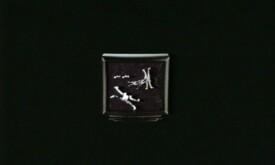


"For an entire generation, people have experienced Star Wars the only way it's been possible...on the TV screen. But if you've only seen it this way, you haven't seen it at all."

The familiar main title music then explodes and a barrage of footage from the films starts playing, including newly created special effects shots. At the age of thirteen, I was dazzled by this concept, and made sure to catch all three of them in theaters during the limited run. I also collected magazines, Taco Bell kids meal toys, and taped all the specials chronicling the Special Editions off television, I was in fanboy heaven to say the least.

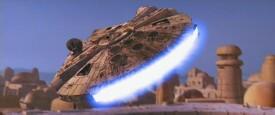


Since their initial release, the Special Editions have received a lot of backlash from Star Wars fans, but the question is, are any aspects of them noteworthy? That being said, I'm going to give a fair analysis of the changes made to the trilogy in 1997, and determine what's notable and what should've never been altered or added. Here we go...
Dewbacks, Banthas and Sandcrawlers


One of the indigenous creatures of Tattooine established in A New Hope was the dewback, a large, lizard-like creature the stormtroopers used as transportation. Due to budget restrictions, only one full-size rubber puppet with very limited mobility was constructed. For the Special Edition, additional footage of CGI dewbacks was created to fully establish their purpose for the Empire. Ultimately, I think the footage is unnecessary and slows the pace of the film down. The whole point of the scene is to establish that the stormtroopers are hot on the trails of C-3PO and R2-D2, and their discovery of the escape pod and the piece of droid metal left behind is all that matters.

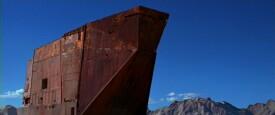
Another alteration is the scene of the Sandcrawler roaming over the hill towards the Lars homestead. The original version featured a scale model slowly creeping along, while the Special Edition features a CGI version moving at a slightly faster pace. This alteration actually isn't bad, it only adds a few extra seconds to the pace of the film, and does offer a grander scale to the vehicle.


For Return of the Jedi, an additional scene preceding Jabba's sail barge featured a herd of wild banthas roaming the sand dunes. While this adds nothing to the narrative, it's also not a bad addition either, the CGI actually looks good, and overall it's kind of a cool moment, as we had only seen banthas primarily as the mount of tuskin raiders.
Mos CGI-ley




The space port of Mos Eisey was redesigned for the Special Edition to be grander and more epic, featuring more citizens, ships, creatures and annoying droids. While this isn't a bad idea per se, it's not essential to the plot either. The amount of digital inserts in this revised sequence at times gets quite obnoxious in its over-cluttering, and I think in the long run, a smaller, more reserved Mos Eisey is actually more believable as part of the barren wastelands of Tattooine.
CGI the Hutt



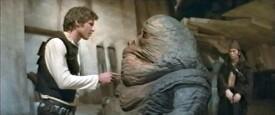
One of the most talked about scenes for the entire trilogy, and one of the only ones to use real archival footage, this scene features Han Solo interacting with Jabba and making arrangements for more time to repay his debt. I remember seeing some of the original footage featured in the vintage documentary From Star Wars to Jedi: The Making of a Saga, where Lucas explained his initial intentions for including that scene and using a stop motion puppet to place over the stand-in actor, but budget restrictions prevented it. I've learned since then that's not factual at all. The scene was actually cut for pacing reasons, and the encounter between Han Solo and Greedo (more on that later...) was altered slightly to include the additional necessary dialogue and streamline the footage. That I strongly believe, as the Jabba the Hutt scene not only redundantly goes over Han's looming issue, but also tampers with Jabba's status as a ruthless gangster, by portraying him as nothing more than a pushover. Do they really expect us to believe that both Jabba and his henchmen would allow Han to blatantly step on his tail without so much as lifting an eyebrow? Not very likely.

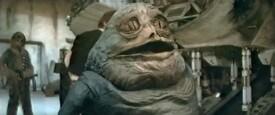


The scene also suffers because it's clear Jabba literally can't fit into that scene, and his dimensions are obviously reduced. Both Return of the Jedi and even The Phantom Menace established Jabba's massive size, and no matter how many times they re-do the CGI for the scene he still appears too small. Sorry, George, despite your love of this sequence, it just doesn't work on so many different levels.
Ships and Shockwaves




For A New Hope during the climax, multiple shots of X-Wing Fighters and TIE-Fighters were replaced by CGI versions. This change actually works, the CGI versions blend with the original model shots very well, and it isn't nearly as obvious and distracting as other scenes.


For the explosions of Alderraan as well as both Death Stars, a CGI shock wave was added for what I can only guess as an excuse to add "scale" to the moments. It's really not needed though, the explosions ILM created back in the day were already large-scale and impressive, and even the original Death Star explosion caused audiences to erupt in cheers, as I've heard. I think the point was made well enough to begin with.




For The Empire Strikes Back, additional footage of the Slave 1 pursuing the Millennium Falcon and Darth Vader taking a shuttle back to the Executioner were added, but these proved to be problematic at best. Not only did they interfere with the musical score and required additional alterations for that aspect, but Vader's flight only slows down the pace of the already tense climax and adds nothing to the narrative. The simple line "Bring my shuttle." is all we need to know that Vader's heading back to his ship, and who cares if he has an entourage waiting for him when he lands?
Greedo Shoots First




Arguably the most widely debated and despised addition adds a level of political correctness to the original movie. The scene features Han Solo running into bounty hunter Greedo with his blaster drawn, and the two sit down at a table to discuss Han's debt to Jabba. The scene originally ended with Han casually drawing his blaster under the table and firing before Greedo can pull the trigger himself. For some reason, Lucas claims he's always felt uncomfortable with the scene, and wanted to dignify Greedo's execution by having him shoot first.


First of all, when someone has a gun pointed at you, that's all the reason you need to defend yourself in any way possible. Secondly, I find it very hard to believe that while Greedo's holding the blaster at point blank range from only a couple feet away that he would miss so horribly. Also, I'm not buying the fact that Han doesn't so much as flinch at the initial blast, not to mention that he actually waits for Greedo to fire seriously deviates from his cool, roguish personality. After all, Han didn't hesitate to fire at Darth Vader in Cloud City, despite the futility of his effort. Overall, the whole alteration is a complete mess, if Lucas hates the original version so much then he should've shot it differently from the start.
"Biggs!"


Prior to the Death Star attack in A New Hope, Luke runs into his friend Biggs and the two briefly converse before boarding their ships. I actually like this scene, it establishes the fact that the two of them have a past and as a result makes Biggs' death later more poignant. It actually surprises me that this scene didn't make the theatrical cut, because it's a good replacement for the long-winded Tattooine footage that was deleted for obvious pacing reasons. Without it, as I said before, the death of Biggs just doesn't have as strong an impact.
The Wampa




One of the problems during the production of The Empire Strikes Back was attempting to get an actor on stilts to efficiently walk while inside the wampa costume, which failed every single time. As a result, the film possessed limited footage of the creature. For the Special Edition, new footage of an actor in a more simplified costume was shot, which definitely looks cool, but in the long run, I think the original version was better. It makes the creature scarier by never getting a really good look at him, similar to the approach of the movie Jaws. Ironically, for both films, malfunctioning animatronics and costumes as a result made the films more effective with their scares. The human mind is a powerful thing, and sometimes it's what we don't physically see that truly gets under our skin.
Cloud City Renovations




For The Empire Strikes Back, Cloud City's corridors now have more windows and balconies to open the place up a little more. Not a bad idea, however in the process of doing this, a glaring continuity error was created. When Lando is leading Han, Leia and Chewie to the dining room, they now pass by a translucent window with an rising elevator outside. But in the following shots, the same window is back to being fully opaque again, oops.
"Jedi Rocks" and Oola




George Lucas always thought it would be a fun idea to just have a silly musical number appear out of nowhere in a Star Wars film. So, for Return of the Jedi, Sy Snootles and the Rebo Band were created to perform the catchy song "Lapti Nek" to lead up to the sudden execution of Jabba's slave Oola. Initially, Sy was a combination of two puppets, one acted as a full size marionette, and the other was a hand puppet of her head for close-ups of her lip syncing. Lucas later felt she didn't look realistic enough, and opted for a fully CGI version of her for the Special Edition. Additionally, more musicians, as well as back-up singers and dancers were created, and the original song was excised in favor of the new "Jedi Rocks" (groan...) tune.
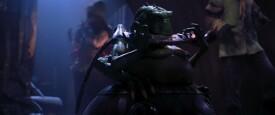



This is the one alteration I've never cared for, even when I was younger. I always loved the original version with the puppet Sy and the "Lapti Nek" song, and never thought the scene needed to be "improved" in any way. The newer version is far too lavish and flamboyant, the song is mediocre and grating, and the CGI version of Sy is completely unconvincing. She looks more like a reject from Who Framed Roger Rabbit, and that being said, I think the hand-drawn characters from that movie have far more dimension and believably. The backlash from fans for this scene propelled Lucas to say these condescending words in the DVD audio commentary:

Oh, George, how willfully ignorant you are. First of all, we're not THAT stupid, we are fully aware that all the creatures are fake. And it's not so hard to determine which has more integrity. When you build a puppet, such as the complex Jabba the Hutt one, and physically shoot it on a set, it already has far more integrity than a digital one added later. The human eye is very good at telling the difference between something live action and something animated. You claim you want to make the characters believable, yet you can't grasp such a simple distinction. Suspension of disbelief is more easily obtained with tricks that are physical, not digital.


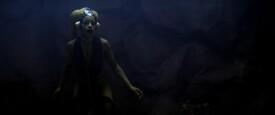

On a lighter note, the sequence is capped off with additional footage of Oola landing at the bottom of the Rancor pit. This scene actually isn't a bad addition, as it doesn't hurt the integrity of the big Rancor reveal later with Luke. It just gives the audience a little something extra, and still maintains the enigmatic nature. What's also kind of cool is that this scene is not from deleted archival footage and was actually shot in 1996 with the same actress (Femi Taylor) who had not physically changed at all in 14 years.

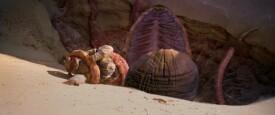
Another sequence Lucas wasn't satisfied with involved in Sarlacc in The Pit of Carkoon. He felt that despite the moving tentacles that nothing felt particularly "alive" about it. For the Special Edition, a new computer generated "beak" of some sort now rises out of the center. The CGI looks okay here, but I can't help but get a certain vibe off it...


A couple lines of dialogue were altered for the Special Edition, the first was for The Empire Strikes Back in the scene where the swamp creature spits R2 out and Luke says, "You're lucky you don't taste very good." The replacement line is "You were lucky to get out of there." From my understanding, this alteration was originally used in certain release prints but was not widely heard, especially not in home video versions, and it's no wonder why. The former version elicits chuckles, while the latter just makes the audience respond, "No $@#&, Sherlock!"
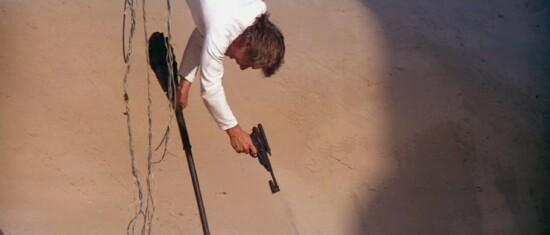
The second altered line is from Return of the Jedi, before Han shoots the Sarlacc's tentacle to rescue Lando. In the original version Han says, "It's all right, trust me!" but in the Special Edition, he says, "It's all right, I can see a lot better!" Again, the humorous aspect of the line is replaced with something clunky and groan inducing, and I can't for the life of me figure out why they'd change a line that truly defined Han Solo's appealing personality.




To close out Return of the Jedi, new footage of various planets was created to broaden the scope of the aftermath of the Death Star's destruction. Actually a good idea, however another musical alteration was done in the process. The original ewok song is now replaced with a rather pedestrian instrumental piece. Sure, we all know many people hate the ewoks and maybe their song wasn't the most dignified way to cap off the trilogy, but it did have a certain charm to it, which is lacking from the replacement score.
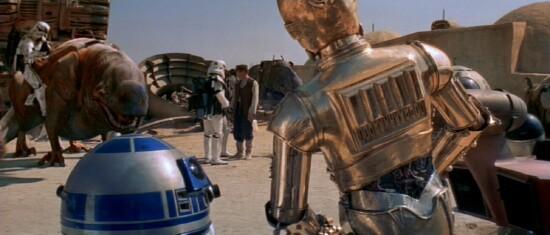
Released on January 31, 1997, Star Wars: Special Edition opened to a unprecedented $35.9 million dollars on it's way to a massive $138.2 million domestically. The Empire Strikes Back: Special Edition was later released on February 21, 1997 to $21.9 million, with a final total of $67.5 million. Return of the Jedi: Special Edition followed with a $16.2 million opening weekend, closing out with a respectable $45.4 million. As you can see, the figures aren't too shabby for a re-release, in fact, it stands as the most successful re-release ever. Ironically, E.T. was the highest grossing film ever made until 1997 when Star Wars finally overtook it, yet couldn't catch back up when given the opportunity in 2002 with its Special Edition re-release.

Sadly, for almost fifteen years now, Lucas has declared these versions to be the only legitimate versions of the Star Wars films. All subsequent VHS releases have featured these versions only, and the DVD releases have even MORE changes added. It's been said that an artist is never satisfied with his work, and it appears that Lucas will continue to tamper with these films until the day he dies. While I, personally don't have a problem with this, he is free to do whatever he wants to his own properties, I still just don't understand why he can't include the original versions as an alternative in home video releases. Those are the versions most Star Wars fans grew to love in their childhoods, and provide the best warm, nostalgic sense of enjoyment in my opinion. Why he'd attempt to try and erase certain aspects of the films is perplexing, especially considering a statement he declared during congressional hearings on the issue of cinematic preservation on March 3, 1988. His exact words were:

"My name is George Lucas. I am a writer, director, and producer of motion pictures and Chairman of the Board of Lucasfilm Ltd., a multi-faceted entertainment corporation.
I am not here today as a writer-director, or as a producer, or as the chairman of a corporation. I've come as a citizen of what I believe to be a great society that is in need of a moral anchor to help define and protect its intellectual and cultural heritage. It is not being protected.
The destruction of our film heritage, which is the focus of concern today, is only the tip of the iceberg. American law does not protect our painters, sculptors, recording artists, authors, or filmmakers from having their lifework distorted, and their reputation ruined. If something is not done now to clearly state the moral rights of artists, current and future technologies will alter, mutilate, and destroy for future generations the subtle human truths and highest human feeling that talented individuals within our society have created.
A copyright is held in trust by its owner until it ultimately reverts to public domain. American works of art belong to the American public; they are part of our cultural history.
People who alter or destroy works of art and our cultural heritage for profit or as an exercise of power are barbarians, and if the laws of the United States continue to condone this behavior, history will surely classify us as a barbaric society. The preservation of our cultural heritage may not seem to be as politically sensitive an issue as "when life begins" or "when it should be appropriately terminated," but it is important because it goes to the heart of what sets mankind apart. Creative expression is at the core of our humanness. Art is a distinctly human endeavor. We must have respect for it if we are to have any respect for the human race.
These current defacements are just the beginning. Today, engineers with their computers can add color to black-and-white movies, change the soundtrack, speed up the pace, and add or subtract material to the philosophical tastes of the copyright holder. Tomorrow, more advanced technology will be able to replace actors with "fresher faces," or alter dialogue and change the movement of the actor's lips to match. It will soon be possible to create a new "original" negative with whatever changes or alterations the copyright holder of the moment desires. The copyright holders, so far, have not been completely diligent in preserving the original negatives of films they control. In order to reconstruct old negatives, many archivists have had to go to Eastern bloc countries where American films have been better preserved.
In the future it will become even easier for old negatives to become lost and be "replaced" by new altered negatives. This would be a great loss to our society. Our cultural history must not be allowed to be rewritten.
There is nothing to stop American films, records, books, and paintings from being sold to a foreign entity or egotistical gangsters and having them change our cultural heritage to suit their personal taste.
I accuse the companies and groups, who say that American law is sufficient, of misleading the Congress and the People for their own economic self-interest.
I accuse the corporations, who oppose the moral rights of the artist, of being dishonest and insensitive to American cultural heritage and of being interested only in their quarterly bottom line, and not in the long-term interest of the Nation.
The public's interest is ultimately dominant over all other interests. And the proof of that is that even a copyright law only permits the creators and their estate a limited amount of time to enjoy the economic fruits of that work.
There are those who say American law is sufficient. That's an outrage! It's not sufficient! If it were sufficient, why would I be here? Why would John Houston have been so studiously ignored when he protested the colorization of "The Maltese Falcon?" Why are films cut up and butchered?
Attention should be paid to this question of our soul, and not simply to accounting procedures. Attention should be paid to the interest of those who are yet unborn, who should be able to see this generation as it saw itself, and the past generation as it saw itself.
I hope you have the courage to lead America in acknowledging the importance of American art to the human race, and accord the proper protection for the creators of that art--as it is accorded them in much of the rest of the world communities."

I don't think the word "ironic" does that transcript any justice. This was spoken just a mere nine years before the Special Edition trilogy was initially released. One may wonder what happened to him in that time to result in such a radical deviation of his former values. Perhaps we will never know. While Lucas has maintained that the Special Editions would be the only versions available from now on, he does appear to be lightening up, and the possibility of the originals released in a modern high-definition format seems a greater possibility now than just a few years ago. It may not be in September's Blu-Ray release, but sometime down the road he will need to give the fans a really good reason to buy the same movies again for the umpteenth time. And what better reason than with what the fans truly want most, I know I'll be amongst the first in line for that without a doubt.

Special thanks to savestarwars.com for the congressional hearing transcript and photo. For further information on the history of Star Wars that George Lucas doesn't want you to know about, I highly recommend The Secret History of Star Wars by Michael Kaminski, a comprehensive and highly engrossing read. You can visit its website at secrethistoryofstarwars.com

Also, be sure to check out a video I personally edited together for funnyordie.com, chronicling the further hypocrisy of George Lucas through vintage interview footage here:
http://FunnyOrDie.com/m/45q6




This is the one alteration I've never cared for, even when I was younger. I always loved the original version with the puppet Sy and the "Lapti Nek" song, and never thought the scene needed to be "improved" in any way. The newer version is far too lavish and flamboyant, the song is mediocre and grating, and the CGI version of Sy is completely unconvincing. She looks more like a reject from Who Framed Roger Rabbit, and that being said, I think the hand-drawn characters from that movie have far more dimension and believably. The backlash from fans for this scene propelled Lucas to say these condescending words in the DVD audio commentary:

"I am still amused by people that somehow think that when you use cyber technology or digital technology in movies, it suddenly, it's fake, that when you look at a scene in here like Jabba's Palace, now there are some digital characters in here, but they're no more or less fake than all the other characters that are in here. I mean, is a digital character more fake than a big, fat, rubber character? (laughs) I mean, there's nothing real here at all! And it's hard to say that, you know, a rubber character has more integrity than a digital character. What I try to do is just make the characters become believable, so they're realistic enough to where you have a suspension of disbelief and accept them as characters, not as tricks, which is what they all are."
Oh, George, how willfully ignorant you are. First of all, we're not THAT stupid, we are fully aware that all the creatures are fake. And it's not so hard to determine which has more integrity. When you build a puppet, such as the complex Jabba the Hutt one, and physically shoot it on a set, it already has far more integrity than a digital one added later. The human eye is very good at telling the difference between something live action and something animated. You claim you want to make the characters believable, yet you can't grasp such a simple distinction. Suspension of disbelief is more easily obtained with tricks that are physical, not digital.




On a lighter note, the sequence is capped off with additional footage of Oola landing at the bottom of the Rancor pit. This scene actually isn't a bad addition, as it doesn't hurt the integrity of the big Rancor reveal later with Luke. It just gives the audience a little something extra, and still maintains the enigmatic nature. What's also kind of cool is that this scene is not from deleted archival footage and was actually shot in 1996 with the same actress (Femi Taylor) who had not physically changed at all in 14 years.
The Sarlacc


Another sequence Lucas wasn't satisfied with involved in Sarlacc in The Pit of Carkoon. He felt that despite the moving tentacles that nothing felt particularly "alive" about it. For the Special Edition, a new computer generated "beak" of some sort now rises out of the center. The CGI looks okay here, but I can't help but get a certain vibe off it...

"Feed me, Seymour!"
Say What?

A couple lines of dialogue were altered for the Special Edition, the first was for The Empire Strikes Back in the scene where the swamp creature spits R2 out and Luke says, "You're lucky you don't taste very good." The replacement line is "You were lucky to get out of there." From my understanding, this alteration was originally used in certain release prints but was not widely heard, especially not in home video versions, and it's no wonder why. The former version elicits chuckles, while the latter just makes the audience respond, "No $@#&, Sherlock!"

The second altered line is from Return of the Jedi, before Han shoots the Sarlacc's tentacle to rescue Lando. In the original version Han says, "It's all right, trust me!" but in the Special Edition, he says, "It's all right, I can see a lot better!" Again, the humorous aspect of the line is replaced with something clunky and groan inducing, and I can't for the life of me figure out why they'd change a line that truly defined Han Solo's appealing personality.
Celebrate Good Times




To close out Return of the Jedi, new footage of various planets was created to broaden the scope of the aftermath of the Death Star's destruction. Actually a good idea, however another musical alteration was done in the process. The original ewok song is now replaced with a rather pedestrian instrumental piece. Sure, we all know many people hate the ewoks and maybe their song wasn't the most dignified way to cap off the trilogy, but it did have a certain charm to it, which is lacking from the replacement score.

Released on January 31, 1997, Star Wars: Special Edition opened to a unprecedented $35.9 million dollars on it's way to a massive $138.2 million domestically. The Empire Strikes Back: Special Edition was later released on February 21, 1997 to $21.9 million, with a final total of $67.5 million. Return of the Jedi: Special Edition followed with a $16.2 million opening weekend, closing out with a respectable $45.4 million. As you can see, the figures aren't too shabby for a re-release, in fact, it stands as the most successful re-release ever. Ironically, E.T. was the highest grossing film ever made until 1997 when Star Wars finally overtook it, yet couldn't catch back up when given the opportunity in 2002 with its Special Edition re-release.

Sadly, for almost fifteen years now, Lucas has declared these versions to be the only legitimate versions of the Star Wars films. All subsequent VHS releases have featured these versions only, and the DVD releases have even MORE changes added. It's been said that an artist is never satisfied with his work, and it appears that Lucas will continue to tamper with these films until the day he dies. While I, personally don't have a problem with this, he is free to do whatever he wants to his own properties, I still just don't understand why he can't include the original versions as an alternative in home video releases. Those are the versions most Star Wars fans grew to love in their childhoods, and provide the best warm, nostalgic sense of enjoyment in my opinion. Why he'd attempt to try and erase certain aspects of the films is perplexing, especially considering a statement he declared during congressional hearings on the issue of cinematic preservation on March 3, 1988. His exact words were:

"My name is George Lucas. I am a writer, director, and producer of motion pictures and Chairman of the Board of Lucasfilm Ltd., a multi-faceted entertainment corporation.
I am not here today as a writer-director, or as a producer, or as the chairman of a corporation. I've come as a citizen of what I believe to be a great society that is in need of a moral anchor to help define and protect its intellectual and cultural heritage. It is not being protected.
The destruction of our film heritage, which is the focus of concern today, is only the tip of the iceberg. American law does not protect our painters, sculptors, recording artists, authors, or filmmakers from having their lifework distorted, and their reputation ruined. If something is not done now to clearly state the moral rights of artists, current and future technologies will alter, mutilate, and destroy for future generations the subtle human truths and highest human feeling that talented individuals within our society have created.
A copyright is held in trust by its owner until it ultimately reverts to public domain. American works of art belong to the American public; they are part of our cultural history.
People who alter or destroy works of art and our cultural heritage for profit or as an exercise of power are barbarians, and if the laws of the United States continue to condone this behavior, history will surely classify us as a barbaric society. The preservation of our cultural heritage may not seem to be as politically sensitive an issue as "when life begins" or "when it should be appropriately terminated," but it is important because it goes to the heart of what sets mankind apart. Creative expression is at the core of our humanness. Art is a distinctly human endeavor. We must have respect for it if we are to have any respect for the human race.
These current defacements are just the beginning. Today, engineers with their computers can add color to black-and-white movies, change the soundtrack, speed up the pace, and add or subtract material to the philosophical tastes of the copyright holder. Tomorrow, more advanced technology will be able to replace actors with "fresher faces," or alter dialogue and change the movement of the actor's lips to match. It will soon be possible to create a new "original" negative with whatever changes or alterations the copyright holder of the moment desires. The copyright holders, so far, have not been completely diligent in preserving the original negatives of films they control. In order to reconstruct old negatives, many archivists have had to go to Eastern bloc countries where American films have been better preserved.
In the future it will become even easier for old negatives to become lost and be "replaced" by new altered negatives. This would be a great loss to our society. Our cultural history must not be allowed to be rewritten.
There is nothing to stop American films, records, books, and paintings from being sold to a foreign entity or egotistical gangsters and having them change our cultural heritage to suit their personal taste.
I accuse the companies and groups, who say that American law is sufficient, of misleading the Congress and the People for their own economic self-interest.
I accuse the corporations, who oppose the moral rights of the artist, of being dishonest and insensitive to American cultural heritage and of being interested only in their quarterly bottom line, and not in the long-term interest of the Nation.
The public's interest is ultimately dominant over all other interests. And the proof of that is that even a copyright law only permits the creators and their estate a limited amount of time to enjoy the economic fruits of that work.
There are those who say American law is sufficient. That's an outrage! It's not sufficient! If it were sufficient, why would I be here? Why would John Houston have been so studiously ignored when he protested the colorization of "The Maltese Falcon?" Why are films cut up and butchered?
Attention should be paid to this question of our soul, and not simply to accounting procedures. Attention should be paid to the interest of those who are yet unborn, who should be able to see this generation as it saw itself, and the past generation as it saw itself.
I hope you have the courage to lead America in acknowledging the importance of American art to the human race, and accord the proper protection for the creators of that art--as it is accorded them in much of the rest of the world communities."

I don't think the word "ironic" does that transcript any justice. This was spoken just a mere nine years before the Special Edition trilogy was initially released. One may wonder what happened to him in that time to result in such a radical deviation of his former values. Perhaps we will never know. While Lucas has maintained that the Special Editions would be the only versions available from now on, he does appear to be lightening up, and the possibility of the originals released in a modern high-definition format seems a greater possibility now than just a few years ago. It may not be in September's Blu-Ray release, but sometime down the road he will need to give the fans a really good reason to buy the same movies again for the umpteenth time. And what better reason than with what the fans truly want most, I know I'll be amongst the first in line for that without a doubt.

Special thanks to savestarwars.com for the congressional hearing transcript and photo. For further information on the history of Star Wars that George Lucas doesn't want you to know about, I highly recommend The Secret History of Star Wars by Michael Kaminski, a comprehensive and highly engrossing read. You can visit its website at secrethistoryofstarwars.com

Also, be sure to check out a video I personally edited together for funnyordie.com, chronicling the further hypocrisy of George Lucas through vintage interview footage here:
http://FunnyOrDie.com/m/45q6
24
Login To Vote!
More Articles From taciturnwes















Comments
11